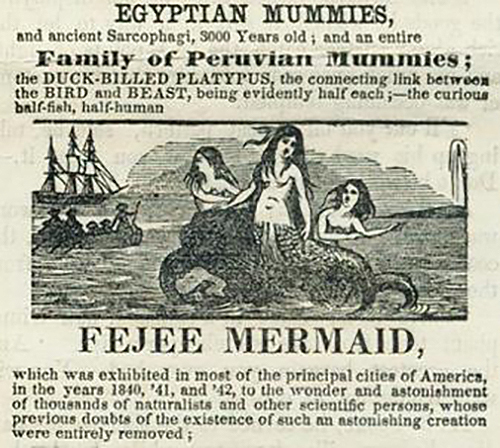Deception
Barnum is also known as a marketing genius who employed deception, which piqued the curiosities of the public. For the purpose of my research, I will solely be exploring his deception through the Feejee Mermaid, which manipulated the public's sentiment in his favor.
Definition
Deception (n.) - the act of causing someone to accept as true or valid what is false or invalid.
Definition based on Merriam Webster.
Feejee Mermaid
Background
Before Barnum
It is reported in an article that the Feejee Mermaid originated in Asia in the 1800s by a Japanese fisherman (Szalay, 2016). It had the top half of a monkey, and the bottom half of a fish. There is no solid evidence as to why this creature was created. This mermaid was acquired by American captain named Samuel Barrett Eades and he exhibited it for travel money (Szalay, 2016). After some time, Eades believed that the mermaid was real. He invited naturalists to confirm it to which some said it was fake, and some said it was real. Eades only wanted to hear what he wanted and deluded himself into thinking that the mermiaid was real. Soon after, the public started to speculate that the mermaid was a fraud, to which it lost its popularity. After being passed around to others, Moses Kimball had possession of the mermaid and suggested Barnum to collaborate together with the exhibition of the mermaid.
Life with Barnum
When Barnum had the mermaid in his possession, he exhibited it at Barnum's American Museum for a month before sending it on tour south of the U.S (Szalay, 2016).
How Did Barnum's Deception Manipulate Public Sentiment in His Favor with the Feejee Mermaid?
Fabricated Stories
Barnum manipulated public sentiment in his favor by fabricating the demand of the Feejee Mermaid. Barnum and Kimball collaborated to create this story before the mermaid was presented. They created fake letters to the press about a Dr. Griffin
and how he had these amazing creatures like the Feejee Mermaid. In reality, this Dr., named Levi Lyman, previously worked on another hoax with Barnum, however his work as Dr. Griffin was a success (Szalay, 2016). Dr. Griffin stuck to the bit and played his role thoroughly.
Barnum truly knew how to toy with the public:
Dr. Griffin and Barnum appeared to have a public tiff, which aroused interest. Barnum wanted to exhibit the mermaid at his new American Museum, but Dr. Griffin refused. Barnum said he had already created publicity materials for the mermaid, and, supposedly unable to use them, gave them to the New York media to use. This made him look generous, but was really a devious way to promote the mermaid... (Szalay, 2016).
Marketing/Advertisements
This certain advertisement by Barnum created this introduction that utilized credible individuals to present the creatures legitimacy:
The public are respectfully informed that, in accordance with numerous and urgent solicitations from scientific gentlemen in this city, Mr. J. Griffin, proprieter of the Mermaid, recently arrived from Penambuco, S. A., has consented to exhibit it to the public, positively for one week only!... ("The Mermaid, and Other Wonderful Specimens of the Animal Creation," 1842)
Barnum deceives the public with the mention of these 'professionals' to manipulate the public sentiments in his favor.Considering these points, it becomes evident that Barnum's deception of the Feejee Mermaid played a significant role in manipulating the public's sentiment in his favor, resulting in his success.



